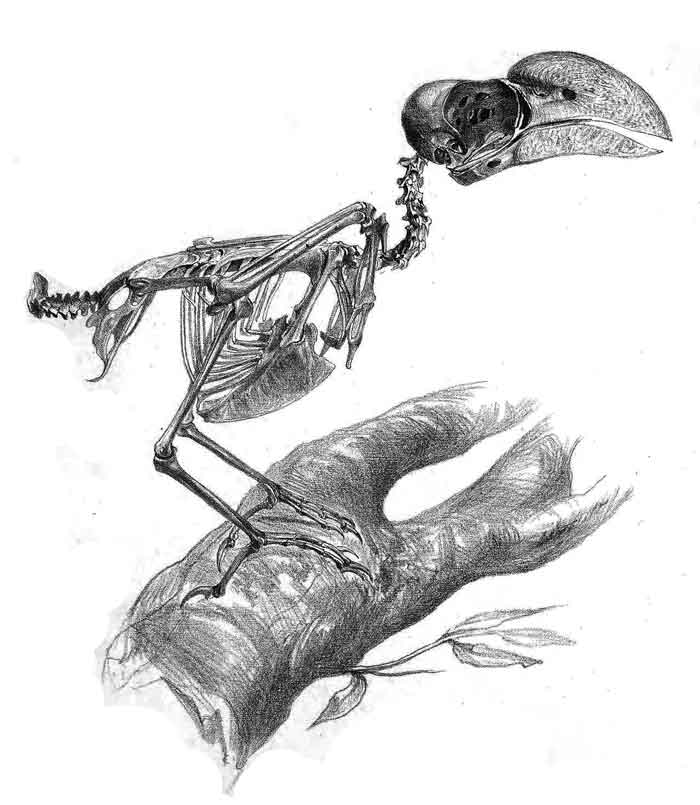
Euryceros prevostii (*)
Superregnum: Eukaryota
Cladus: Unikonta
Cladus: Opisthokonta
Cladus: Holozoa
Regnum: Animalia
Subregnum: Eumetazoa
Cladus: Bilateria
Cladus: Nephrozoa
Superphylum: Deuterostomia
Phylum: Chordata
Subphylum: Vertebrata
Infraphylum: Gnathostomata
Megaclassis: Osteichthyes
Cladus: Sarcopterygii
Cladus: Rhipidistia
Cladus: Tetrapodomorpha
Cladus: Eotetrapodiformes
Cladus: Elpistostegalia
Superclassis: Tetrapoda
Cladus: Reptiliomorpha
Cladus: Amniota
Classis: Reptilia
Cladus: Eureptilia
Cladus: Romeriida
Subclassis: Diapsida
Cladus: Sauria
Infraclassis: Archosauromorpha
Cladus: Crurotarsi
Divisio: Archosauria
Cladus: Avemetatarsalia
Cladus: Ornithodira
Subtaxon: Dinosauromorpha
Cladus: Dinosauriformes
Cladus: Dracohors
Cladus: Dinosauria
Cladus: Saurischia
Cladus: Eusaurischia
Subordo: Theropoda
Cladus: Neotheropoda
Cladus: Averostra
Cladus: Tetanurae
Cladus: Avetheropoda
Cladus: Coelurosauria
Cladus: Tyrannoraptora
Cladus: Maniraptoromorpha
Cladus: Maniraptoriformes
Cladus: Maniraptora
Cladus: Pennaraptora
Cladus: Paraves
Cladus: Eumaniraptora
Cladus: Avialae
Infraclassis: Aves
Cladus: Avebrevicauda
Cladus: Pygostylia
Cladus: Ornithothoraces
Cladus: Ornithuromorpha
Cladus: Carinatae
Parvclassis: Neornithes
Cohors: Neognathae
Cladus: Neoaves
Cladus: Telluraves
Cladus: Australaves
Ordo: Passeriformes
Subordo: Passeri
Infraordo: Corvida
Superfamilia: Corvoidea
Familia: Vangidae
Genus: Euryceros
Species: Euryceros prevostii
Name
Euryceros prevostii Lesson, 1831
References
Lesson, R.P., 1831: Description d'un nouveau genre d'Oiseau, l'Eurycère, Euryceros. Annales des sciences naturelles : comprenant La physiologie animale et végétale, l'anatomie comparée des deux règnes, la zoologie, la botanique, la minéralogie et la géologie, 22: 421–423.Originial description: p. 422 BHL pl. 12 fig. 1 BHL.
IUCN: Euryceros prevostii (Endangered)
Vernacular names
العربية: ضغام
български: Шлемоноса ванга
català: Vanga de casc
Cymraeg: Fanga helmog
Deutsch: Helmvanga
English: Helmet Vanga
español: vanga de casco
eesti: Suurnokk-vanga
فارسی: وانگای کلاهخودی
suomi: Kypärävanga
français: Eurycère de Prévost
עברית: ונגת הקסדה
magyar: Sisakos vanga
മലയാളം: ഹെൽമറ്റ് വാൻഗ
Nederlands: Helmvanga
norsk: Stornebbvanga
polski: Hełmodziób
português: Vanga-de-prévost
русский: Шлемоносная ванга
svenska: hjälmvanga
українська: Ванга товстодзьоба
The helmet vanga (Euryceros prevostii) is a distinctive-looking bird of the vanga family, Vangidae, and is classified in its own genus, Euryceros. It is mainly blue-black, with rufous wings and a huge arched blue bill. It is restricted to lowland and lower montane rainforests of northeastern Madagascar. Its diet is composed of invertebrates, predominantly insects. The species is threatened by habitat loss.
Taxonomy
The helmet vanga is the only member of the genus Euryceros. Like most vangas it was originally placed in the shrike family, Laniidae. When the ornithologist Austin L. Rand moved the majority of the vangas into a separate family in 1936, he placed the helmet vanga in its own monotypic family, Eurycerotidae. It was moved to the vanga family by J. Dorst in 1960. The closest relative within the family is believed to be the rufous vanga, which is thought to have split from the helmet vanga 800,000 years ago.[2] The specific name prevostii commemorates the French artist Florent Prévost.

Skeleton of helmet vanga
Description
Global distribution
The helmet vanga is a large vanga, the second-largest species of vanga after the sickle-billed vanga. In length it measures 28 to 31 cm (11–12 in), and it weighs 84 to 114 g (3.0–4.0 oz). The most distinctive feature is the massive hooked bill, which is 51 mm (2.0 in) long and 30 mm (1.2 in) deep.[2] The plumage of the head, neck, throat, breast and belly is a solid blue-black, as are the primary coverts and remiges of the wing. The mantle, the back, and the rest of the wings are rufous. The tail, which is long and broad, is black below and rufous above. The bill is bright blue with a black tip. Both sexes are alike.[2]
Distribution and habitat
It is restricted to lowland and lower montane rainforests in north-eastern Madagascar. Sites where it can be found include Marojejy National Park, Makira Natural Park, the Masoala National Park and Mantadia National Park.
Behaviour
Adults mainly eat large insects, but food items brought to young in the nest may be more varied, including snails, lizards, spiders and crabs.
Breeding
Helmet vangas are monogamous and seasonal breeders. The breeding season runs from October to January on the Masoala Peninsula. Both sexes work on the construction of the nest, which is a cup shape 15 cm (5.9 in) in diameter constructed from woven plant fibres, mosses and twigs, and is placed in a fork in a tree 2 to 4 m (6.6–13.1 ft) off the ground. There is one record of courtship feeding by a male before copulation. The clutch size is two or three pinkish white eggs.[3]
Threats and conservation
The helmet vanga is considered to be threatened with extinction due to habitat loss. The species is restricted to undisturbed humid rainforest, and this habitat is increasingly being cleared for agriculture and forestry. Their population, between 6000-15000 mature individuals, is becoming increasingly fragmented.[1] Ecological modelling suggests that much of their remaining habitat will be lost in 50 years due to climate change. Because of these issues the species has been listed as vulnerable by the IUCN.[1]
References
BirdLife International (2018). "Euryceros prevostii". IUCN Red List of Threatened Species. 2018: e.T22708058A131736320. doi:10.2305/IUCN.UK.2018-2.RLTS.T22708058A131736320.en. Retrieved 11 November 2021.
Rocamora, Gérard; Yeatman-Berthelot, Dosithée (2009). "Family Vangidae (Vangas)". In del Hoyo, Josep; Elliott, Andrew; Christie, David (eds.). Handbook of the Birds of the World. Volume 14: Bush-shrikes to Old World Sparrows. Barcelona: Lynx Edicions. pp. 142–170. ISBN 978-84-96553-50-7.
La Marca, Giuseppe; Russell Thorstrom (2000). "Breeding biology, diet and vocalization of the Helmet Vanga, Euryceros prevostii, on the Masoala Peninsula, Madagascar". Ostrich. 71 (3–4): 400–403. doi:10.1080/00306525.2000.9639840. S2CID 84507844.
Further reading
Graetz, J. (1991) Nest observations of the Helmet Vanga Euryceros prevostii Newsletter of the Working Group on Madagascar Birds 1: 2.
Powzyk, J. (1995) Exceptional observations in Mantadia National Park Newsletter of the Working Group on Madagascar Birds 5 (2): 4
Safford, Roger (2000) Photospot: Helmet Vanga Bulletin of the African Bird Club volume 7.1
Retrieved from "http://en.wikipedia.org/"
All text is available under the terms of the GNU Free Documentation License

